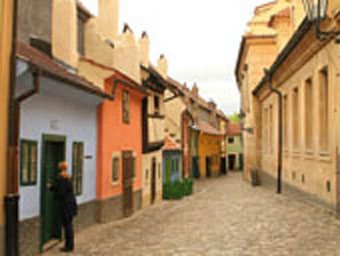
Prague Castle (Pražskýhrad)
Prague is quite different from places which I have been to in other countries in terms of charging admission fees. Income from tourism being the main source of revenue, almost all the public restrooms had a woman sitting at the entrance collecting an admission fee. I once rescued a flustered and embarrassed tourist with 10 Korunas in entering a public restroom because Euros were not accepted in Prague. However, before 7 A.M. in the morning, I could march into Prague Castle without spending a cent, because, between 5 A.M. and 9 A.M., it is free to walk the grounds of the castle, including the Golden Lane.
I thought I was a careful planner, but I forgot about Prague’s rainy summer. The rain was sudden and heavy. When it came pouring down on me, I struggled to take pictures while holding the umbrella to protect my Canon, anxiously hoping for 9 o’clock to arrive so that I could buy a ticket to go indoors. As it turned out, I did not last till 9 o’clock, and fled to the hotel from the doorstep of number 22 of the Golden Lane.
Was it regrettable to miss seeing the interiors of the St. Vitus Cathedral? Yes, but it was not really a big loss. Though I liked the atmosphere of the cathedral, I was not obsessed. Looking at its magnificent exteriors from the plaza was just as nice. The construction of this cathedral began in 1344, and was not finished until 1929 when the rose windows were installed. I discovered later that manybuildings in Prague took a long time to complete. It took 2 centuries to complete the Charles Bridge, but this cathedral took 5 centuries to finish. It appears that the Czech people have no rivals in insisting on taking their time to do things right.
Do the Czech people have patience? I’m not sure. Though not passionate, they are friendly enough. Not knowing the language, when I needed directions, I would pleasantly stop seemingly-kind passersby and point to my destination on the map. They would point the directions to me to show if I was lost or heading the right way. Then I would thank them in Czech, the only Czech I knew, and they responded with heartfelt smiles in their eyes. My journey in Prague was entirely made possible with this ever successful “GPS” of smiles, hand gestures, and my Czech “Thank you.” I was never good with directions, but during my 5 days in Prague, I never lost my way and was even twice approached by other tourists for directions. What a new experience!
St. Vitus Cathedral was built in the Gothic style. I read somewhere that the term “Gothic” was used in the 17th century to describe a style that was dark and mysterious, though those who built cathedrals in the Middle Ages did not label the style of their work. The term “Gothic” first appeared in the correspondence of Italian Renaissance intellectuals, who conceitedly regarded the soaring architecture style to be characteristic of the northern Gothic barbarians.
How do we identify a Gothic cathedral? The most notable element is the design of the flying buttress, which possess great support for the height of the building to surpass Roman architecture.
I’m actually more interested in the history of architecture and the characteristics of architectural structure than in cathedrals themselves, because the history and the structure enable me to observe modes of human thinking and behavioral changes. I learned that most cathedral entrances were west-facing, symbolizing the Archbishop facing Jerusalem, with the light from the setting sun gradually fading from the entrance.
Opposed to the grandeur of St. Vitus Cathedral, the Golden Lane had the houses of the Seven Dwarfs. In the 16th century, these little dwellings along the Stag Moat housed the castle guards and their families. In the 17th century, King Rudolf’s alchemists lived there. Hence the name of Golden Lane. Subsequently these houses became the gathering places of literary figures. Franz Kafka used to live in 22 Golden Lane. In the 1940’s, Madam de Thebes predicted from her residence at 4 Golden Lane that the Nazis would fail and she was killed by the Gestapo.
To sum up, many legendary tales really took place in these picturesque little houses that look like they belong in books. |